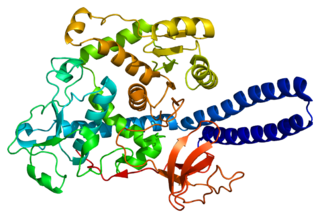Alpha-(1,3)-fucosyltransferase is an enzyme that in humans is encoded by the FUT7 gene. [5] [6] [7]
Alpha-(1,3)-fucosyltransferase is an enzyme that in humans is encoded by the FUT7 gene. [5] [6] [7]
The sialyl Lewis x oligosaccharide determinant is an essential component of leukocyte counterreceptors for E-selectin- (MIM 131210) and P-selectin- (MIM 173610) mediated adhesions of leukocytes. This oligosaccharide molecule is displayed on the surfaces of granulocytes, monocytes, and natural killer cells. Formation of leukocyte adhesions to these selectins is an early and important step in the process that ultimately allows leukocytes to leave the vascular tree and become recruited into lymphoid tissues and sites of inflammation.[supplied by OMIM] [7]

Selectin P ligand, also known as SELPLG or CD162, is a human gene.

The selectins are a family of cell adhesion molecules. All selectins are single-chain transmembrane glycoproteins that share similar properties to C-type lectins due to a related amino terminus and calcium-dependent binding. Selectins bind to sugar moieties and so are considered to be a type of lectin, cell adhesion proteins that bind sugar polymers.

E-selectin, also known as CD62 antigen-like family member E (CD62E), endothelial-leukocyte adhesion molecule 1 (ELAM-1), or leukocyte-endothelial cell adhesion molecule 2 (LECAM2), is a selectin cell adhesion molecule expressed only on endothelial cells activated by cytokines. Like other selectins, it plays an important part in inflammation. In humans, E-selectin is encoded by the SELE gene.

Sialyl LewisX (sLeX) also known as cluster of differentiation 15s (CD15s) or stage-specific embryonic antigen 1 (SSEA-1), is a tetrasaccharide carbohydrate which is usually attached to O-glycans on the surface of cells. It is known to play a vital role in cell-to-cell recognition processes. It is also the means by which an egg attracts sperm; first, to stick to it, then bond with it and eventually form a zygote. The discovery of the essential role that this tetrasaccharide plays in the fertilization process was reported in August 2011.

In molecular biology, CD18 is an integrin beta chain protein that is encoded by the ITGB2 gene in humans. Upon binding with one of a number of alpha chains, CD18 is capable of forming multiple heterodimers, which play significant roles in cellular adhesion and cell surface signaling, as well as important roles in immune responses. CD18 also exists in soluble, ligand binding forms. Deficiencies in CD18 expression can lead to adhesion defects in circulating white blood cells in humans, reducing the immune system's ability to fight off foreign invaders.

Beta-galactoside alpha-2,6-sialyltransferase 1 is an enzyme that in humans is encoded by the ST6GAL1 gene.
In enzymology, a peptide-O-fucosyltransferase is an enzyme that catalyzes the chemical reaction in which an alpha-L-fucosylpyranoside residue is transferred from GDP-beta-L-fucose to the sidechain oxygen atom of a serine or threonine residue in a protein.

Galactoside 3(4)-L-fucosyltransferase is an enzyme that in humans is encoded by the FUT3 gene.

Beta-1,3-galactosyl-O-glycosyl-glycoprotein beta-1,6-N-acetylglucosaminyltransferase is an enzyme that in humans is encoded by the GCNT1 gene.

Alpha-(1,3)-fucosyltransferase is an enzyme that in humans is encoded by the FUT6 gene.

Alpha-(1,6)-fucosyltransferase is an enzyme that in humans is encoded by the FUT8 gene.

Carbohydrate sulfotransferase 4 is an enzyme that in humans is encoded by the CHST4 gene.

Alpha-(1,3)-fucosyltransferase is an enzyme that in humans is encoded by the FUT9 gene.

Alpha-2,8-sialyltransferase 8B is an enzyme that in humans is encoded by the ST8SIA2 gene.

Carbohydrate sulfotransferase 1 is an enzyme that in humans is encoded by the CHST1 gene.

Synaptotagmin-like protein 1 is a protein that in humans is encoded by the SYTL1 gene.

Carbohydrate sulfotransferase 5 is an enzyme that in humans is encoded by the CHST5 gene.

Alpha-N-acetylgalactosaminide alpha-2,6-sialyltransferase 1 is an enzyme that in humans is encoded by the ST6GALNAC1 gene. This enzyme adds a N-Acetylneuraminic acid to an O-linked N-Acetylgalactosamine (GalNAc) on a peptide/proteins with an α2-6 linkage to produce the sialyl-Tn antigen. It has been shown that the enzyme prefers Thr over Ser containing GalNAc residues.

Alpha-(1,3)-fucosyltransferase is an enzyme that in humans is encoded by the FUT5 gene.
O-linked glycosylation is the attachment of a sugar molecule to the oxygen atom of serine (Ser) or threonine (Thr) residues in a protein. O-glycosylation is a post-translational modification that occurs after the protein has been synthesised. In eukaryotes, it occurs in the endoplasmic reticulum, Golgi apparatus and occasionally in the cytoplasm; in prokaryotes, it occurs in the cytoplasm. Several different sugars can be added to the serine or threonine, and they affect the protein in different ways by changing protein stability and regulating protein activity. O-glycans, which are the sugars added to the serine or threonine, have numerous functions throughout the body, including trafficking of cells in the immune system, allowing recognition of foreign material, controlling cell metabolism and providing cartilage and tendon flexibility. Because of the many functions they have, changes in O-glycosylation are important in many diseases including cancer, diabetes and Alzheimer's. O-glycosylation occurs in all domains of life, including eukaryotes, archaea and a number of pathogenic bacteria including Burkholderia cenocepacia, Neisseria gonorrhoeae and Acinetobacter baumannii.